You are using an out of date browser. It may not display this or other websites correctly.
You should upgrade or use an alternative browser.
You should upgrade or use an alternative browser.
Lockheed A-12 and SR-71 projects
- Thread starter SOC
- Start date
-
- Tags
- aerospace defense command air defence air defense command central intelligence agency cold war general electric aircraft engines lockheed nuclear battlefield pratt & whitney sead skunk works strategic air command strategic bomber strategic defence strategic reconnaissance united states united states air force united states navy
- Joined
- 9 October 2009
- Messages
- 22,033
- Reaction score
- 13,732

Lockheed SR-71A: Anyone fancy a shot of TEB?
Triethylborane (TEB), a sweet poison which ignites spontaneously upon exposure to oxygen, was used to start Habu’s J58s and also to ignite the afterburners. Saturday Night, My Friends.
I read an unpublished interview of Bill Park (second pilot to fly the A-12) in which he didn't say the fastest or highest flights. He regarded the question as irrelevant. He said it was hard enough to get the aircraft to fly at the specified speed and altitude, do a 180° turn, and come back, so that Lockheed would have met the terms of the contract and could get paid.JimK said:FighterJock said:So what was faster in terms of overall speed? A-12 or SR-71A? I have heard many stories over the years that the SR-71A was faster than the A-12, could someone clear this up for me. :-\
From COMIREX-D-12.1/1 (Approved for release Date: Aug 2007)
I would interpret the equality of Mach numbers listed as a propulsion system limitation.
Thanks for that JimK, good information that has gone on to help me with my initial problem. B)
- Joined
- 19 December 2011
- Messages
- 225
- Reaction score
- 445
The performance characteristics of the Blackbirds have all been fully declassified.
Mach 3.32 was the design cruise speed, but maximum allowable Mach number was dependent on outside air temperature and its effect on compressor inlet temperature (CIT). The pilot was authorized to accelerate to Mach 3.3 as long as CIT remained at or below 427 degrees Centigrade. Speeds exceeding Mach 3.3 were occasionally recorded, but generally the pilot tried to avoid this area of the performance envelope because it placed excessive thermal stress on the airframe.
Some maximum speed milestones:
YF-12A, 1 May 1965, Mach 3.14 (2,070 mph)
A-12, 8 May 1965, Mach 3.29 (2,171 mph)
SR-71A, 28 July 1976, Mach 3.32 (2,193 mph)
The Blackbirds were designed to cruise at 85,000 feet with a useful fuel load and reconnaissance payload. Because the A-12 was 20,000 pounds lighter than the SR-71, it had an altitude capability about 3,000 feet higher than that attained by the SR-71 at any given point in a flight profile for missions of the same range.
Some maximum altitude milestones:
YF-12A, 1 May 1965, 80,257 feet
SR-71A, 1968, 89,650 feet
A-12, 14 August 1965, 90,000 feet
In 1975, Lockheed studied the possibility of expanding the flight envelope of the SR-71 with some modifications. The results of several studies concluded the maximum speed limit could be extended to Mach 3.5 for short periods of time. The only structural limit to speeds above Mach 3.5 was a KEAS (knots equivalent airspeed) limit of 420, set by inlet duct pressures and temperatures that exceeded acceptable values. Limited inlet capture-area and excessive engine CIT also limited operation at higher Mach numbers, even with proposed modifications.
Similar studies addressed the possibility of achieving flights well above 85,000 feet. results indicated the SR-71 could briefly reach an altitude of about 95,000 feet in a zoom-climb profile. The proposed mission could have been accomplished with an airplane having a gross-weight of 85,000 pounds. According to the flight profile, the pilot would accelerate from Mach 3.2 to 3.5 at an altitude of 80,000 feet, then zoom to 95,000 feet as speed decreased to normal cruise mach numbers. The airplane would subsequently settle back down to an altitude of about 84,000 feet. Sustained flight above 85,000 feet was limited by wing surface-area and engine thrust capabilities.
Mach 3.32 was the design cruise speed, but maximum allowable Mach number was dependent on outside air temperature and its effect on compressor inlet temperature (CIT). The pilot was authorized to accelerate to Mach 3.3 as long as CIT remained at or below 427 degrees Centigrade. Speeds exceeding Mach 3.3 were occasionally recorded, but generally the pilot tried to avoid this area of the performance envelope because it placed excessive thermal stress on the airframe.
Some maximum speed milestones:
YF-12A, 1 May 1965, Mach 3.14 (2,070 mph)
A-12, 8 May 1965, Mach 3.29 (2,171 mph)
SR-71A, 28 July 1976, Mach 3.32 (2,193 mph)
The Blackbirds were designed to cruise at 85,000 feet with a useful fuel load and reconnaissance payload. Because the A-12 was 20,000 pounds lighter than the SR-71, it had an altitude capability about 3,000 feet higher than that attained by the SR-71 at any given point in a flight profile for missions of the same range.
Some maximum altitude milestones:
YF-12A, 1 May 1965, 80,257 feet
SR-71A, 1968, 89,650 feet
A-12, 14 August 1965, 90,000 feet
In 1975, Lockheed studied the possibility of expanding the flight envelope of the SR-71 with some modifications. The results of several studies concluded the maximum speed limit could be extended to Mach 3.5 for short periods of time. The only structural limit to speeds above Mach 3.5 was a KEAS (knots equivalent airspeed) limit of 420, set by inlet duct pressures and temperatures that exceeded acceptable values. Limited inlet capture-area and excessive engine CIT also limited operation at higher Mach numbers, even with proposed modifications.
Similar studies addressed the possibility of achieving flights well above 85,000 feet. results indicated the SR-71 could briefly reach an altitude of about 95,000 feet in a zoom-climb profile. The proposed mission could have been accomplished with an airplane having a gross-weight of 85,000 pounds. According to the flight profile, the pilot would accelerate from Mach 3.2 to 3.5 at an altitude of 80,000 feet, then zoom to 95,000 feet as speed decreased to normal cruise mach numbers. The airplane would subsequently settle back down to an altitude of about 84,000 feet. Sustained flight above 85,000 feet was limited by wing surface-area and engine thrust capabilities.
greenmartian2017
The Shadow knows what lurks in the hearts of men
- Joined
- 13 May 2008
- Messages
- 173
- Reaction score
- 151
Whisperstream, while what you have written seems the standard response, I can tell you unequivocally that the A-12 flew faster than those "speed" and "altitude" milestones you have recorded here. On the 20 November 1965, during operation Silver Javelin, an A-12 went much faster than 3.2 and flew appreciably higher than 90,000. This is alluded to in the excellent book "Lockheed Blackbird: Beyond the Secret Missions" by Paul Crickmore (revised edition), but without the actual data numbers. What was the exact speed? The aircraft went through a patch of exceptionally cold air, which is a boon to attaining higher speed. It accelerated to (based on what I was told) Mach 3.47 and perhaps an altitude of greater than 93,000 feet. (It may have been as much as 95 or 96K, but the person who was telling me this couldn't remember exactly.) I don't recall the exact duration for this unprecedented speed. Now I have heard rumors that the Mach number I have stated here actually has the two decimal places switched around wrong. But I can't say more, because I don't have any further data. But I thought I would include the rumor also.
I would welcome the actual Mach number and altitude figure for this particular mission. I would like actual facts about this. But this is what was verbally told to me.
I would welcome the actual Mach number and altitude figure for this particular mission. I would like actual facts about this. But this is what was verbally told to me.
Viper2000
I really should change my personal text
- Joined
- 8 June 2018
- Messages
- 28
- Reaction score
- 51
The aircraft went through a patch of exceptionally cold air, which is a boon to attaining higher speed. It accelerated to (based on what I was told) Mach 3.47 and perhaps an altitude of greater than 93,000 feet. (It may have been as much as 95 or 96K, but the person who was telling me this couldn't remember exactly.)
Mach number is simply the ratio between the speed of the flow or aeroplane and the local speed of sound.
The local speed of sound is proportional to the square root of the absolute static temperature.
Flying through a cold patch of air therefore increases MN without changing the aircraft's speed at all. The flight manual specifically warns about this behaviour. Concorde had similar problems IIRC.
e.g. Mach 3.2 at 80,000' is 1853.5 KTAS on a standard day. At ISA - 20 K, this same TAS corresponds to Mach 3.35.
It would be possible to get 3.47 MN with a temperature change of about 35 K.
The flight envelope diagram is on the next page, followed by an illustration of MN vs OAT and CIT. On a cold day, the MN and hence TAS corresponding to a fixed CIT is increased, because the temperature ratio across the intake is a function of the MN (see e.g. equation 7).
Flying very high is easy for fast aeroplanes because of their prodigious kinetic energy; zooming 10,000' or more really wouldn't be a problem. If the autopilot was in Mach hold and was controlling MN with pitch, it's quite possible that a big temperature shear would naturally produce such a zoom climb. The most likely explanation for the very big numbers is therefore just flying through a big temperature shear with the autopilot in Mach hold mode.
Steady state is another matter. It is likely that a good example could go a bit higher than the book figure at light weights, but the chances are that the handling qualities and risk of inlet unstart were considered unacceptable when set against any increase in survivability (likely to be negligible).
The other thing to consider is altimeter position error, which might well be a function of indicated MN and might have contributed to an exaggerated increase in indicated pressure altitude.
To really understand what was going on, you'd need to compare the pitot static measurements with INS data.
Resister1976
ACCESS: Confidential
- Joined
- 9 April 2021
- Messages
- 71
- Reaction score
- 46
Resister1976
ACCESS: Confidential
- Joined
- 9 April 2021
- Messages
- 71
- Reaction score
- 46
On that book,It seems to be called B-71,but I didn't find the same but clearer picture in this Web forumsI look it from a old book that is from the library.
Resister1976
ACCESS: Confidential
- Joined
- 9 April 2021
- Messages
- 71
- Reaction score
- 46
From RAINBOW to GUSTO:……(The text was damaged)Hi Resister1976,
what was this book ?,and do you mean it was a bomber version ?.
yes,a bomber version of SR-71,There are three cavity on the left side and right side,not like the F-12B、RB-12 and FB-12
Resister1976
ACCESS: Confidential
- Joined
- 9 April 2021
- Messages
- 71
- Reaction score
- 46
thanks,and I find the second half of the pictureFrom Crowood's book,by Steve Pace.
Resister1976
ACCESS: Confidential
- Joined
- 9 April 2021
- Messages
- 71
- Reaction score
- 46
At last,I wish you have a good healthFrom Crowood's book,by Steve Pace.
Ravinoff
Hoodoo Operator
- Joined
- 5 October 2017
- Messages
- 131
- Reaction score
- 299
Not the worst idea I've ever heard, actually thought about it a few times myself. Payload is obviously going to be extremely limited, the A-12 would have carried three AIM-47 Falcons at around ~800lbs each in individual bays...that fits the size and weight of a B61 pretty well. So three dial-a-yield gravity bombs with settings up to 400Kt or so each, on a Mach 3+ airframe. Really feels like that should be useful for something, but I'm drawing a blank on what.
- Joined
- 3 June 2011
- Messages
- 18,369
- Reaction score
- 12,324
Or four SRAMs with 500 mile range.Not the worst idea I've ever heard, actually thought about it a few times myself. Payload is obviously going to be extremely limited, the A-12 would have carried three AIM-47 Falcons at around ~800lbs each in individual bays...that fits the size and weight of a B61 pretty well. So three dial-a-yield gravity bombs with settings up to 400Kt or so each, on a Mach 3+ airframe. Really feels like that should be useful for something, but I'm drawing a blank on what.
blackkite
Don't laugh, don't cry, don't even curse, but.....
- Joined
- 31 May 2007
- Messages
- 8,822
- Reaction score
- 7,729
Attachments
Last edited:
- Joined
- 26 May 2006
- Messages
- 34,946
- Reaction score
- 15,838
I think the concept of using the SR as a maritime strike platform with a KE weapon comes purely from a few paragraphs in Kelly's own autobiography rather than any on-paper proposal:But there was no conventional version of SRAM and its inertial guidance wasn't really suitable for conventional strike, especially against maritime targets.
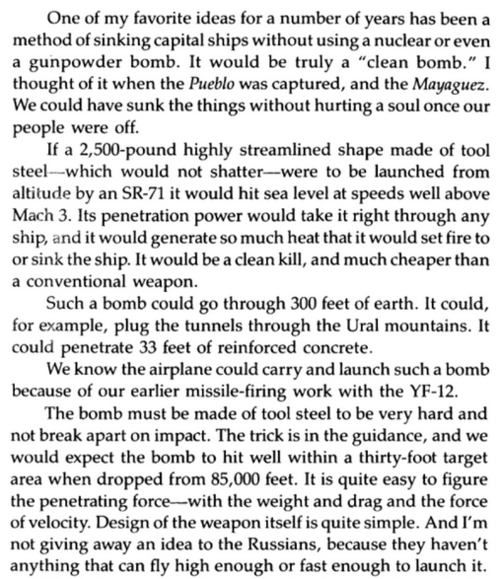
aonestudio
I really should change my personal text
- Joined
- 11 March 2018
- Messages
- 2,967
- Reaction score
- 7,507
Why... yes. Yes there are.Folks,
Are there any artists' impressions or three-views that show what an operational F-12B would have looked like? I'd love to built it in 1/72 one day.

D
Deleted member 2278
Guest
Nitrous-Oxide Injection SR-71:
- Joined
- 19 December 2011
- Messages
- 225
- Reaction score
- 445
Can someone mention the LASRE tests carried out by the SR-71?
There is a lot of information online. You might wish to start with the basics:

Linear Aerospike SR-71 Experiment (LASRE)
The NASA/Lockheed Martin Linear Aerospike SR-71 Experiment (LASRE) concluded its flight operations phase in November 1998.
Essentially, the Blackbird acted as a "flying wind tunnel" by carrying a dorsally mounted, subscale, half-span X-33 model. Plans called for aerodynamic studies, cold flow tests, and finally a hot-fire. Unfortunately, due to safety concerns, the hot fire never took place.
One of my fondest memories is of standing off to one side and slightly behind the SR-71 during engine start prior to a LASRE test mission in October 1997. Those V8 start carts were super loud, and the green flash of TEB was awesome. Good times.
kenfalzon
I really should change my personal text
- Joined
- 22 September 2011
- Messages
- 33
- Reaction score
- 19
Thanks my friend.Can someone mention the LASRE tests carried out by the SR-71?
There is a lot of information online. You might wish to start with the basics:

Linear Aerospike SR-71 Experiment (LASRE)
The NASA/Lockheed Martin Linear Aerospike SR-71 Experiment (LASRE) concluded its flight operations phase in November 1998.www.nasa.gov
Essentially, the Blackbird acted as a "flying wind tunnel" by carrying a dorsally mounted, subscale, half-span X-33 model. Plans called for aerodynamic studies, cold flow tests, and finally a hot-fire. Unfortunately, due to safety concerns, the hot fire never took place.
One of my fondest memories is of standing off to one side and slightly behind the SR-71 during engine start prior to a LASRE test mission in October 1997. Those V8 start carts were super loud, and the green flash of TEB was awesome. Good times.
I am a modeller and wish to find a clear photo of the rear part of the canoe where the exhaust pipes lie, as the shape there is not very clear.
- Joined
- 3 September 2006
- Messages
- 1,476
- Reaction score
- 1,475
Not very clear, best I have.I am a modeller and wish to find a clear photo of the rear part of the canoe where the exhaust pipes lie, as the shape there is not very clear.
You may want to get the highest-rez photos in the Nasa library with refs EC-98-44440-4, EC97-44295-108, EC98-44440-4. And snoop around while there.
Attachments
- Joined
- 3 June 2011
- Messages
- 18,369
- Reaction score
- 12,324
Did you actually look? Less than a minute of work yielded these:Thanks my friend.Can someone mention the LASRE tests carried out by the SR-71?
There is a lot of information online. You might wish to start with the basics:

Linear Aerospike SR-71 Experiment (LASRE)
The NASA/Lockheed Martin Linear Aerospike SR-71 Experiment (LASRE) concluded its flight operations phase in November 1998.www.nasa.gov
Essentially, the Blackbird acted as a "flying wind tunnel" by carrying a dorsally mounted, subscale, half-span X-33 model. Plans called for aerodynamic studies, cold flow tests, and finally a hot-fire. Unfortunately, due to safety concerns, the hot fire never took place.
One of my fondest memories is of standing off to one side and slightly behind the SR-71 during engine start prior to a LASRE test mission in October 1997. Those V8 start carts were super loud, and the green flash of TEB was awesome. Good times.
I am a modeller and wish to find a clear photo of the rear part of the canoe where the exhaust pipes lie, as the shape there is not very clear.
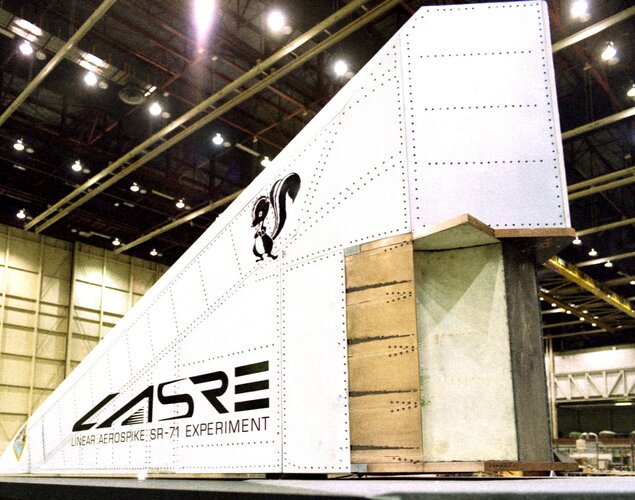

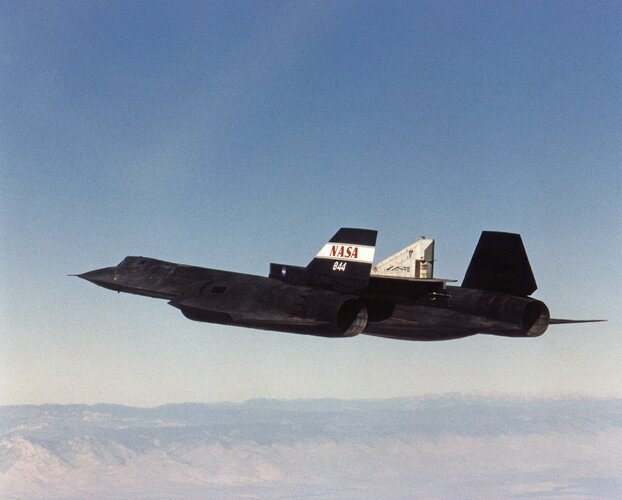
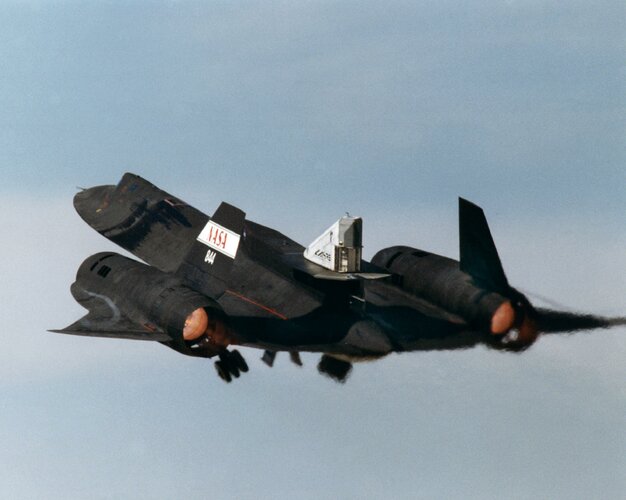
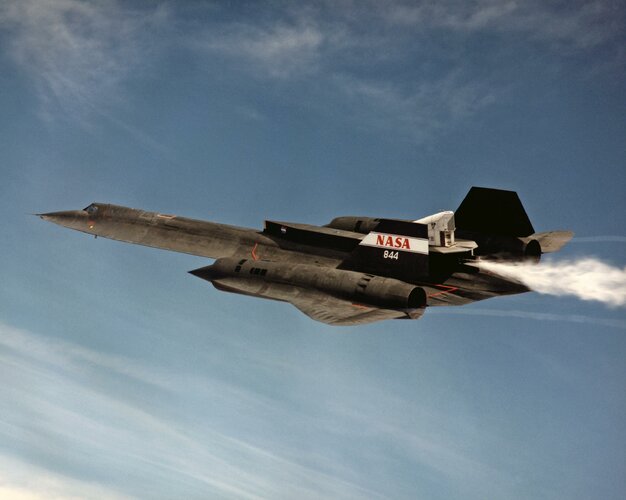
- Joined
- 19 December 2011
- Messages
- 225
- Reaction score
- 445
Good shots of the left side of the half-span test article. You will also need a decent picture of the right side as there is a difference in detail on the uppermost aft plate, a small round hole several centimeters in diameter. I could provide greater detail, and photos, but my library is temporarily inaccessible.
I remember (vaguely) reading something somewhere a long time ago about Kelly Johnson saying that a penetrator shape made from hardened tool steel with a guidance nose could be used to take out missile silos. Again a long time ago but I recall him mentioning in the article how many feet of reinforced it concrete it would go through vaporizing much in its path and obviously destroying the missile without using a nuke to do so.Madoc said:Wow. Interesting to see what applications Kelly Johnson and crew would come up with for their CIA special. I recall one proposal for the A-12/SR-71 was to use the thing in an anti-ship capacity. The rounds for the task simply being big rods of titanium with some guidance equipment attached. The reasoning being that the kinetic energy imparted unto the target vessel by a few thousand pound projectile after it'd been fired/dropped by the Blackbird going at Mach 3+ would suffice to vaporize a goodly chunk of the enemy ship.
I can't see that working - titanium is very low density for a penetrator (tungsten would be much better) and it would lose velocity after launch, and mach 3 is not that fast by the standard of naval projectiles. It would be like getting hit by a dud 16" naval round at worst. Something like a Harpoon missile would be far more deadly.
So I'm not sure if this is the right place to ask this, but what were the size of the weapon bays for the yf-12?
I ask because the aim-47 had a proposal in 59 to increase the diameter by two inches inorder to add a ir seeker. It wasn't done because it would no longer fit in the f-108, and I was thinking they could insted also add folding wings inorder to fit in the f-108. now im not very sure the new increase in diameter would exclude the missile from the f-12, after all they folding wings on the aim-47 were created for the f-12 sense the aim-47 couldn't fit as they were. But looking at the engineering drawings there seems to be enough room? At lest from side to side for a 2 inch extension, I can't tell if it would be to tall for the bays or not.
I ask because the aim-47 had a proposal in 59 to increase the diameter by two inches inorder to add a ir seeker. It wasn't done because it would no longer fit in the f-108, and I was thinking they could insted also add folding wings inorder to fit in the f-108. now im not very sure the new increase in diameter would exclude the missile from the f-12, after all they folding wings on the aim-47 were created for the f-12 sense the aim-47 couldn't fit as they were. But looking at the engineering drawings there seems to be enough room? At lest from side to side for a 2 inch extension, I can't tell if it would be to tall for the bays or not.
aonestudio
I really should change my personal text
- Joined
- 11 March 2018
- Messages
- 2,967
- Reaction score
- 7,507
Twitter...
Photoshop is a hell of a drug.
- Joined
- 29 July 2009
- Messages
- 1,782
- Reaction score
- 2,556
Not as clear, but a starboard view of LASER and a ground test video of LASER.
View: https://www.youtube.com/watch?v=UN9KJWkNfFQ
Attachments
Last edited:
He confirmed late that it was Photoshop- the contrails just didn't match the engine spacing imhoTwitter...
Photoshop is a hell of a drug.
He confirmed late that it was Photoshop- the contrails just didn't match the engine spacing imhoTwitter...
Photoshop is a hell of a drug.
The fact that the aircraft was pointed in a different direction from the contrails was another subtle hint.
aonestudio
I really should change my personal text
- Joined
- 11 March 2018
- Messages
- 2,967
- Reaction score
- 7,507
aonestudio
I really should change my personal text
- Joined
- 11 March 2018
- Messages
- 2,967
- Reaction score
- 7,507
aonestudio
I really should change my personal text
- Joined
- 11 March 2018
- Messages
- 2,967
- Reaction score
- 7,507
Similar threads
-
-
-
Project ISINGLASS & Project RHEINBERRY
- Started by flateric
- Replies: 374
-
-
Lockheed SR-71/YF-12 Blackbirds (Dennis R. Jenkins)
- Started by overscan (PaulMM)
- Replies: 3












